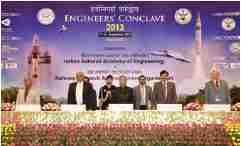“Formulation of an aerospace policy”, “Government investments for selective infrastructure required for aerospace manufacturing”, setting up and “Aviation University” and enhanced budget for R&D in Government letter as well as in private industries, are among the salient recommendations emerging from the “Engineers Conclave-2013” that concluded here 19 Sep 2013. Panel discussions and brain storming to evolve solutions for the problems faced related to production and manufacturing in aerospace sector on one hand and those associated with the development of Sunderbans region on the other hand, were the proceedings.
Inaugurated by President of India Pranab Mukherjee, the conclave concluded with a valedictory function chaired by Dr. R Chidambaram, Principal Scientific Advisor (SA) to Govt. of India in the presence of Conclave Chair and SA to Defence Minister Avinash Chander and Secretary Dept. of Def R&D , GC Pati, Secretary, Dept. of Defence Production and Dr. Baldev Raj, President, INAE besides scientists from DRDO, Dept. of Atomic energy, Indian Space Research Organization, Ministry of Earth Sciences, Indian National Academy of Engineering (INAE) fellows and champions from the industry.
Highlighting the need for taking advance technologies to common people for solving their problems, Dr Chiambaram applauded DRDO’s efforts for providing bridges in the region of Uttrakhand after the recent disaster and congratulated the INAE for taking up the two extremely important issues namely “Production and manufacturing in aerospace” and “Technology solutions for Sunderbans”.
Summing up the two day long conclave, Avinash Chander, stated that there was a current requirement of 2000 missiles and 20 LCAs per year against a current production capacity of 200 missiles and 2 LCAs per year. “We expect the requirements to go way beyond. This and the corresponding requirement in other sectors such as civilian aircrafts, UAVs etc. will make it multifold growth. For this what we need is a high precision manufacturing infrastructure, capacity and skill set, where there seems to be a vital gap.”


